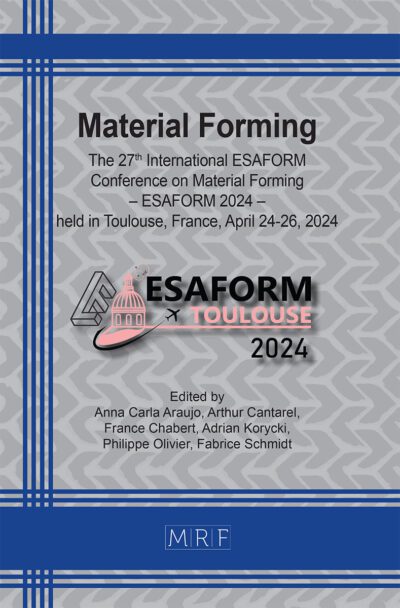Significance of the material parameters within a three-dimensional solid-shell element for thermoforming simulation
Johannes Mitsch, Bastian Schäfer, Luise Kärger
Abstract. In this study, a hexahedral solid-shell element is employed for the simulation of the thermoforming processes for unidirectionally reinforced thermoplastic tapes. This allows for the direct application of a fully three-dimensional material behavior, in contrast to conventional two-dimensional approaches that neglect thickness deformations. However, the additional material parameters increase the computational effort during characterization. It is therefore crucial to distinguish the material parameters that have a significant influence on the final forming result from those that have a negligible impact. The results reveal that rate-dependent material modelling has the most significant influence on the final forming results. Therefore, it is crucial to accurately model the viscoelastic behavior to simulate thermoforming appropriately. Furthermore, the material parameters that describe the in-plane tension behavior are relevant for accurately predicting the material draw-in. The transverse shear stiffnesses for both the membrane and the bending behavior show low significance due to the low laminate thicknesses. Similarly, low bending stiffnesses, e.g., the elastic bending perpendicular to the fiber direction, are also of negligible significance compared to the high rate-dependency in those deformation modes.
Keywords
Solid-Shell, Forming, Process Simulation, Finite Element Analysis (FEA)
Published online 5/7/2025, 10 pages
Copyright © 2025 by the author(s)
Published under license by Materials Research Forum LLC., Millersville PA, USA
Citation: Johannes Mitsch, Bastian Schäfer, Luise Kärger, Significance of the material parameters within a three-dimensional solid-shell element for thermoforming simulation, Materials Research Proceedings, Vol. 54, pp 363-372, 2025
DOI: https://doi.org/10.21741/9781644903599-40
The article was published as article 40 of the book Material Forming
![]() Content from this work may be used under the terms of the Creative Commons Attribution 3.0 license. Any further distribution of this work must maintain attribution to the author(s) and the title of the work, journal citation and DOI.
Content from this work may be used under the terms of the Creative Commons Attribution 3.0 license. Any further distribution of this work must maintain attribution to the author(s) and the title of the work, journal citation and DOI.
References
[1] P. Bussetta, N. Correia, Numerical forming of continuous fibre reinforced composite material: A review, Composites Part A: Applied Science and Manufacturing 113 (2018) 12–31. https://doi.org/10.1016/j.compositesa.2018.07.010
[2] S.P. Haanappel, R.H.W. Thije, U. Sachs, B. Rietman, R. Akkerman, Formability analyses of uni-directional and textile reinforced thermoplastics, Composites Part A: Applied Science and Manufacturing 56 (2014) 80–92. https://doi.org/10.1016/j.compositesa.2013.09.009
[3] P. Boisse, N. Hamila, E. Vidal-Sallé, F. Dumont, Simulation of wrinkling during textile composite reinforcement forming. Influence of tensile, in-plane shear and bending stiffnesses, Composites Science and Technology 71 (2011) 683–692. https://doi.org/10.1016/j.compscitech.2011.01.011
[4] S. Allaoui, P. Boisse, S. Chatel, N. Hamila, G. Hivet, D. Soulat, E. Vidal-Salle, Experimental and numerical analyses of textile reinforcement forming of a tetrahedral shape, Composites Part A: Applied Science and Manufacturing 42 (2011) 612–622. https://doi.org/10.1016/j.compositesa.2011.02.001
[5] D. Dörr, F.J. Schirmaier, F. Henning, L. Kärger, A viscoelastic approach for modeling bending behavior in finite element forming simulation of continuously fiber reinforced composites, Composites Part A: Applied Science and Manufacturing 94 (2017) 113–123. https://doi.org/10.1016/j.compositesa.2016.11.027
[6] D. Dörr, T. Joppich, D. Kugele, F. Henning, L. Kärger, A coupled thermomechanical approach for finite element forming simulation of continuously fiber-reinforced semi-crystalline thermoplastics, Composites Part A: Applied Science and Manufacturing 125 (2019). https://doi.org/10.1016/j.compositesa.2019.105508
[7] B. Schäfer, D. Dörr, L. Kärger, Potential and challenges of a solid-shell element for the macroscopic forming simulation of engineering textiles, ESAFORM 2021 (2021). https://doi.org/10.25518/esaform21.883
[8] B. Schäfer, D. Dörr, L. Kärger, Reduced-Integrated 8-Node Hexahedral Solid-Shell Element for the Macroscopic Forming Simulation of Continuous Fibre-Reinforced Polymers, Procedia Manufacturing 47 (2020) 134–139. https://doi.org/10.1016/j.promfg.2020.04.154
[9] M. Schwarze, S. Reese, A reduced integration solid-shell finite element based on the EAS and the ANS concept-Geometrically linear problems, Int. J. Numer. Meth. Engng. 80 (2009) 1322–1355. https://doi.org/10.1002/nme.2653
[10] M. Schwarze, S. Reese, A reduced integration solid-shell finite element based on the EAS and the ANS concept-Large deformation problems, Int. J. Numer. Meth. Engng. 85 (2011) 289–329. https://doi.org/10.1002/nme.2966
[11] J. Mitsch, B. Schäfer, J.P. Wank, L. Kärger, Considering the viscoelastic material behavior in a solid-shell element for thermoforming simulation, in: Material Forming: ESAFORM 2024, Materials Research Forum LLC, 2024. https://doi.org/10.5445/IR/1000170492
[12] J.C. Simo, F. Armero, R.L. Taylor, Improved versions of assumed enhanced strain tri-linear elements for 3D finite deformation problems, Computer Methods In Applied Mechanics And Engineering 110 (1993) 359–386.
[13] J.C. Simo, F. Armero, Geometrically non-linear enhanced strain mixed methods and the method of incompatible modes, Int. J. Numer. Meth. Engng. 33 (1992) 1413–1449. https://doi.org/10.1002/nme.1620330705
[14] J.C. Simo, M.S. Rifai, A class of mixed assumed strain methods and the method of incompatible modes, Int. J. Numer. Meth. Engng. 29 (1990) 1595–1638. https://doi.org/10.1002/nme.1620290802
[15] T.J.R. Hughes, T.E. Tezduyar, Finite Elements Based Upon Mindlin Plate Theory With Particular Reference to the Four-Node Bilinear Isoparametric Element, J. Appl. Mech 48 (1981) 587–596. https://doi.org/10.1115/1.3157679
[16] M. Schwarze, I.N. Vladimirov, S. Reese, On the implementation of the EAS and ANS concept into a reduced integration continuum shell element and applications to sheet forming, Int J Mater Form 2 (2009) 919–922. https://doi.org/10.1007/s12289-009-0634-2
[17] B.B.J. Schäfer, Macroscopic forming simulation of unidirectional non-crimp fabrics: Hyperelastic material modeling and 3D-solid-shell approach, Dissertation, Karlsruher Institut für Technologie (KIT), 2024. https://publikationen.bibliothek.kit.edu/1000170739
[18] A. Bertram, Elasticity and Plasticity of Large Deformations: Including Gradient Materials, Springer, 2021.
[19] T. Belytschko, W.K. Liu, B. Moran, K.I. Elkhodary, Nonlinear finite elements for continua and structures, 2. ed., 1. publ, Wiley, Chichester, 2014.
[20] C.W. Macosko, Rheology: Principles, measurements, and applications, Wiley-VCH, New York NY u.a., 1994.
[21] D. Dörr, F. Henning, L. Kärger, Nonlinear hyperviscoelastic modelling of intra-ply deformation behaviour in Finite element forming simulation of continuously fibre-reinforced thermoplastics, Composites Part A: Applied Science and Manufacturing (2018). https://doi.org/10.1016/j.compositesa.2018.03.037
[22] D. Dörr, Simulation of the thermoforming process of UD fiber-reinforced thermoplastic tape laminates, Dissertation, Karlsruhe, 2019. https://doi.org/10.5445/IR/1000099485













